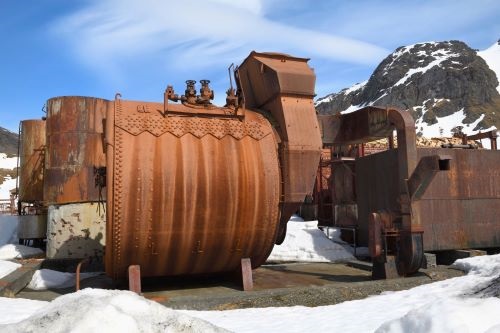How To Prevent Rust From
Occurring in Your Applications
Nobody likes rust. Rust damages the appearance of a material and can prevent an application from working effectively.
The corrosion process, which is a reaction between metals and oxygen, occurs due to oxidation. Oxidation is a destructive molecular reaction between oxygen and metal surfaces.
Once rust takes over any metal, it can be hard to get rid of. However, there are various methods that one can implement to prevent rust from forming.

Rust Prevention Methods
The best way to prevent rust is to prevent moisture from coming in contact with the metal, or by using a material that corrodes slowly. There are a few rust prevention methods that have proven to be effective:
-
Use an Alloy: Alloys, like stainless steel, are one of the most common ways to prevent rust or slow it down. All metals corrode. However, they each corrode at different rates. Alloys are made from two or more metals and are more resistant to rusting. The elements in an alloy react with oxygen from water and air to form a thin, stable film that consists of such corrosion products as metal oxides and hydroxides. The presence of the stable film prevents additional corrosion by acting as a barrier that limits oxygen and water access to the underlying metal surface.
-
Apply Oil: Applying a coating of oil will inhibit moisture from reaching into the metal, which helps prevent rust. Oil not only helps with lubrication, but it allows the parts to move with less friction. Oil also forms a protective coating that acts as a barrier against rust. However, an oily surface may cause problems for a few tools or machines.
-
Apply a Dry Coating: There are products that have properties specially designed to prevent rust and dry with no residue. These products form a protective barrier over metal equipment. Rust preventative dry coating is ideal for metal components that need to stay dry. These are effective for products to use in shipping, storage, etc.
-
Paint the Metal: A good quality paint can slow down the rusting process by preventing moisture from reaching the metal. It is important to use paint that can adhere to metal. It is also important to get an oil-based paint (not water-soluble paint) if you expect that your metal part will encounter excessive moisture or contaminants.
-
Blueing: This process of blueing involves creating a layer of magnetite over the metal to prevent rust. The metal must be regularly oiled to maintain rust resistance. The process is called blueing because it will turn blue or black in the process. Blueing is accomplished by using a salt solution and high temperatures.
-
Powder Coating: Powder coating, like painting, covers metal in a protective layer. A layer of epoxy, acrylic, or vinyl will prevent rust by preventing moisture from reaching the metal.

Volatile Corrosion Inhibitors
One type of technology that inhibits rust from forming on metals is VCI. VCI stands for volatile corrosion inhibitor, vapor corrosion inhibitor, or Vapor Phase Corrosion Inhibitor. VCI is a technology that simplifies the corrosion process and is ideal for keeping things like packages, equipment, and metal cavities rust-free. VCIs work by releasing molecules from corrosion inhibiting compounds into the air.
When these compounds touch metal surfaces, they form a thin layer of molecules. This thin layer of molecules prevents air and moisture from coming into contact with the surface, which effectively inhibits corrosion. VCIs are considered one of the better rust prevention methods because the corrosion inhibiting molecules have the ability to reach surfaces that would be otherwise hard to reach with traditional rust prevention products. The function of the VCI is to transform from a solid or a liquid into a gas. The gas molecule then absorbs and takes to the surface of the metal, which forms a molecular barrier layer. This layer then blocks other molecules, like water or oxygen from attaching to steel surfaces.
This effectively minimizes the potential for corrosion. VCIs can also neutralize the corrosive effect of oxygen and water. This works by mixing VCI powder with water. Water acts as a method of delivery for the powder to travel to where it is needed.
VCIs Applied Against Equipment VS. Incorporated In Material
VCIs can be applied against equipment or incorporated into a material. VCI technology evolved from VCI paper, where VCIs were used to wrap parts for transportation and storage, to the development of VCI film. VCI film incorporates corrosion inhibitors into plastic films. The advantage of VCI incorporation was that parts could be stored with the film without Rust Preventative (RP) oil. The oil would typically have to be removed before a part was used. Large equipment has been wrapped in VCI shrink film for long-term outdoor storage. Steel structures are in a constant cycle of maintenance and are susceptible to various elements.
VCI coating offers superior protection by using epoxy primer and VCI technology. VCI coating, when added to military-grade epoxy, allows the application to continue functioning in less than ideal conditions. VCIs applied against a material allow for flexible surface preparation schedules and continuous corrosion protection.
This is a cost-effective solution for rust prevention and steel structure maintenance. Steel is expensive and thus it is critical to maintaining it to ensure a long life. Steel is an essential material that is used almost everywhere from cars to cutlery. Thus, to maintain steel and prevent it from rusting, it is important to take precautionary measures to ensure maximum protection of equipment and machinery.
Griff-Shrink® is a patented multi-ply heat-shrinkable laminate that is heat shrinkable and combines the performance of polyethylene and specialty heat-shrinkable films supported with a reinforcement grid to create a highly tear-resistant and durable product. Griff-Shrink® 3-ply VCI consists of layers of UV stabilized polyethylene, cord reinforcement, and high-strength shrinkable film. Our 5-ply VCI product combines alternating layers of reinforcing between three layers of specialty shrink films and polyethylene for a heavy-duty cover.

